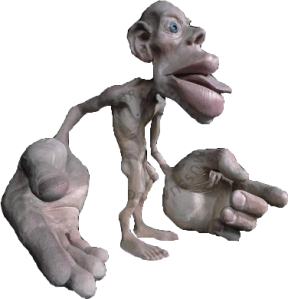The Homunculus

Homunculus is a funny and distorted drawing of a small human figure, the sizes of whose limbs are proportional to their sensitivity. The more sensitive parts of the body are the hands, lips, face and tongue, since they have more receptors than the knees or the back.
In many ways, the sense of touch stands apart from the other senses. It is not localized in a specialized organ like the eyes and ears but covers the entire surface of the body.
There are two types of touch receptors–one of them dealing with touching sensation and the other dealing with pain and temperatures.
Touch receptors are nerve cells that have globular swellings on their terminals. Pain and temperature receptors have free nerve endings and lack the globular swellings on their terminals.
These receptors feed into the central nervous system in such a way that it can create a map. Our central nervous system preserves the map even to the level of the brain.
These receptors are not evenly distributed all over the body. More Cerebral cortex is used to process the feeling of touch from the more sensitive areas like the hands, lips, face and tongue.
When the figure of a man is drawn with his limbs proportional to the cerebral cortex used in the process of touch, we get this strange and distorted diagram called Homunculus.
More sensitive organs appear magnified and the less sensitive organs appear dimished giving rise to a funny manikin!
Visalakshi Ramani

Homunculus is a funny and distorted drawing of a small human figure, the sizes of whose limbs are proportional to their sensitivity. The more sensitive parts of the body are the hands, lips, face and tongue, since they have more receptors than the knees or the back.
In many ways, the sense of touch stands apart from the other senses. It is not localized in a specialized organ like the eyes and ears but covers the entire surface of the body.
There are two types of touch receptors–one of them dealing with touching sensation and the other dealing with pain and temperatures.
Touch receptors are nerve cells that have globular swellings on their terminals. Pain and temperature receptors have free nerve endings and lack the globular swellings on their terminals.
These receptors feed into the central nervous system in such a way that it can create a map. Our central nervous system preserves the map even to the level of the brain.
These receptors are not evenly distributed all over the body. More Cerebral cortex is used to process the feeling of touch from the more sensitive areas like the hands, lips, face and tongue.
When the figure of a man is drawn with his limbs proportional to the cerebral cortex used in the process of touch, we get this strange and distorted diagram called Homunculus.
More sensitive organs appear magnified and the less sensitive organs appear dimished giving rise to a funny manikin!
Visalakshi Ramani